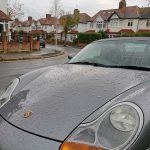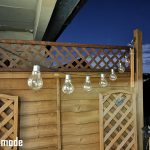Camera
Moving onto our look at the triple camera of the Mate 20 Pro, it is worth refreshing our memories of the three cameras on the back. As with the P20 Pro, we have a 40MP f/1.8 primary shooter (though by default this takes photos at 10MP) as well as an 8MP f/2.4 telephoto camera. Instead of the 20MP monochrome camera, though, the Mate 20 Pro has a 20MP f/2.2 ultra wide-angle lens – something we have not seen from Huawei before.
We'll break this camera analysis down into sections, starting with overall out-of-the-box image quality using the primary camera.
General image quality
Overall impressions from the primary camera on the Mate 20 Pro are certainly positive – it's very similar to the P20 Pro in this regard, which is not surprising as the primary camera is very similar, if not identical, to that of the P20 Pro. That means images come out looking sharp, detailed and generally very well exposed right out of the camera. Dynamic range is also very good using the default auto mode – there is a HDR mode that needs to be manually selected, but honestly I can't tell the difference between photos taken in HDR mode compared to photos taken in auto mode.
If you wondering about the camera's AI, too, this has been improved but essentially works the same way as with the Mate 10 Pro and P20 Pro – if the camera sees a dog, it optimises the photo for a dog, and if it sees food, it optimises for food and so on. I've written previously that I don't much like the AI image processing, and that stays true here – but thankfully, Huawei has actually turned the AI off by default, so none of the images above were taken using the AI enhancements.
That being said, that doesn't stop me from thinking that the photos produced are still a bit over-processed. It is more obvious in some photos than others, but the photos look a bit over-sharpened to my eye, and saturation can also be a bit much depending on the scene. Take the photo of the pizza above as an example – I promise you, the tomato sauce looked nowhere near as vibrant red in real life.
I don't mind the colours looking a little bit over-done – most of the time you can fix that in post processing – but it is the over-sharpening that gets me most. I find this most noticeable when looking at trees or buildings – you can see the edges have just been sharpened up fairly aggressively and to my eye, it just makes the overall scene look slightly artificial, almost cartoonish.
Again, this doesn't seem to happen with every photo – but fairly regularly a photo will come out just looking a bit over-done. I certainly think Huawei has tweaked things to the point where the Mate 20 Pro looks more natural than the P20 Pro, but for me I like a photo to come out as natural as possible, and I can edit it later if I want. It still seems to me that Huawei is taking that decision out of your hands slightly.
To be fair, a lot of people seem to like this additional processing – photos are ready to go straight onto Instagram with no edits required. So perhaps I'm just part of a small minority who prefers a cleaner, more natural photo – but either way, I have to say how it looks to me.
Ultra wide-angle
The new addition to the camera setup is the ultra wide lens, though, so it is only right we look at that. Above you can see 10 different scenes, each shot with the primary lens and then the new ultra wide.
Having used a number of ultra wide solutions on various different phones – including the ASUS ZenFone 5 and LG G6, for instance – I have to say Huawei's implementation is by far the best I've used. Other ultra wide lenses introduce a fair amount of very noticeable barrel distortion, but there is almost none of that here, despite the significantly increased field of view (FOV).
On top of that, Huawei has kept the colours quite consistent throughout the wide and ultra wide cameras, when other phones with ultra wide lenses produce wildly different results in terms of colour if you compare their wide and ultra wide images.
Yes, the photos do again seem to be over-sharpened a bit – I would say it is more noticeable with the ultra wide camera than with the primary wide camera – but that becomes less of a concern with an ultra wide I think, as the sheer scale of the photo is much more eye catching than the perhaps overly aggressive sharpening. For me at least, my eye is drawn more to the whole scene rather than individual elements where you can notice the extra sharpening.
So on the whole, I really like the ultra wide lens. It is simply an excellent tool for architectural shots or landscapes and I think Huawei has done a great job with its implementation here – like I said, it's the best ultra wide I've ever used.
Camera versatility
The addition of the ultra wide lens, coupled with the already excellent telephoto lens which has been brought over from the P20 Pro, creates what I think is probably the most versatile mobile shooting solution currently on the market. That's because you have what is the equivalent of a 16-135mm lens (in 35mm full-frame terms) on the back of the phone, when all the lenses are working together.
To point that out, I have taken 4 photos of 4 different scenes above – one with the ultra wide (0.6x), one with the primary (1x), one with the telephoto (3x) and then a hybrid telephoto shot that combines the telephoto data with the data from the 40MP sensor to create an even closer 5x zoom.
The photos themselves aren't the best, but the point I am making is just how much you can do with this phone's camera now – from capturing an ultra wide city shot, right down to zooming in on a subject in close detail. It is quite impressive.
Night mode
One last area of the camera to look at is night mode. The functionality of this hasn't changed since the P20 Pro, so the phone still takes a succession of photos at different exposures (over 4 or 5 seconds) and then intelligently combines them – like a mega HDR mode.
I have found this mode to be much more reliable with the Mate 20 Pro, however – with the P20 Pro I found it to be a bit hit and miss, but I can only assume Huawei has slightly tweaked how the mode meters different scenes, as now probably 9 times out of 10, the night mode shot will come out looking better than auto mode.
It's still not perfect, and again it can look over-sharpened depending on the subject and lighting conditions, but in low light it certainly helps to create a punchy image that minimises grain and has an even exposure.
Battery
It is no secret Huawei's flagships have long had excellent battery life – both the Mate 10 Pro and P20 Pro have 4000mAh cells, and accordingly they gave me top results in the battery department. When I saw the 4200mAh cell used with the Mate 20 Pro, I must say I was sceptical – I did not think a 200mAh increase would be enough to offset the move to a bigger, brighter and higher resolution 6.39in 3120x1440p display.
It turns out I was wrong – battery life is again excellent, and definitely in the same ballpark as the P20 Pro. That means I would typically come to the end of the day with around 40-45% battery capacity remaining – sometimes more if I hadn't been doing much on my phone. That makes the battery life easily enough to last a day and a half, maybe even two if you are a light user. Power users, though, should still be able to get a full day out of this phone.
Even if you can't quite manage that – which would take some doing, mind – Huawei's SuperCharge is the fastest I have ever used. This 40W charger comes in the box, and with it Huawei claims you can get a 70% charge in 30 minutes. I put this to test, and used the SuperCharger for exactly 30 minutes. At the start of the test, my battery was at 15% – 30 minutes later, it had gone up to 83%, making it a 68% increase. It's not quite the full 70%, but it is still extraordinary.
One feature I am less sure of, is reverse wireless charging. This is a new feature which lets the Mate 20 Pro act as a portable wireless charger for another Qi-enabled phone – just stick your Mate 20 Pro on the back of another phone, and that phone will start charging.
It sounds very cool and handy, but it is very slow – I tested my Mate 20 Pro with a Samsung S7, and that phone got a 7% charge after 50 minutes. I also think it's not hugely practical, as you would have to leave your phone down for a significant amount of time without using it for the other phone to get any meaningful charge.
In some scenarios it could certainly prove helpful – if you're out for dinner and a friend's phone dies, you could give them just enough juice to call a taxi and get home – but for the most part, I have to say this is probably more of a gimmick than anything revolutionary. Who knows what Huawei might be able to do with the tech in the future, though, so let's see how it can develop.
Be sure to check out our sponsors store EKWB here
 KitGuru KitGuru.net – Tech News | Hardware News | Hardware Reviews | IOS | Mobile | Gaming | Graphics Cards
KitGuru KitGuru.net – Tech News | Hardware News | Hardware Reviews | IOS | Mobile | Gaming | Graphics Cards


































































